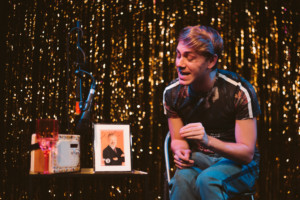Review: IN CONVERSATION WITH GRAHAM NORTON, The Hope Theatre

![]() The titular character in Batavia Productions' In Conversation with Graham Norton is a small framed photograph from Norton's BBC Radio 2 show, which has been signed. He doesn't say much. The photograph is placed on top of an Eighties-style wireless by the lead and only character, Mark, played by Jay Parsons.
The titular character in Batavia Productions' In Conversation with Graham Norton is a small framed photograph from Norton's BBC Radio 2 show, which has been signed. He doesn't say much. The photograph is placed on top of an Eighties-style wireless by the lead and only character, Mark, played by Jay Parsons.
Mark has been inspired by Saturday morning feature, "Grill Graham", to talk through his problems and his worries, his hopes and his dreams, with someone who earns a living through talking to people about their lives and helping them with their issues.
This play doesn't shy away from some of the biggest problems facing teenagers, from sexuality to suicide and eating disorders. Parsons portrays the 17-year-old Mark with a poignant naivety, and he sees these issues from a childlike, simple perspective, discussing them in earnest.
The fact Mark seems young for his age is compounded by his new-looking, matching Mr Men socks, as well as his love for a simple Christmas cracker joke - and his ability to keep laughing at it for a whole year. It is this friction, as the innocent character tries to come to terms with adult concepts, which drives the play. For Mark, it is an attempt at a journey of discovery as he asks himself, "How can I be myself, when I don't know who I am?".
Parsons has a great energy, and the one-man play is propelled forwards for the whole hour it lasts. Not only does he balance narrative, conversation with himself and commentary as Mark, his voice transitions seamlessly between other characters when their presence is necessary to his story.
However, for these sections, a microphone is also used to separate the one actor's different characters, which seems unnecessary. Parsons is skilled enough to differentiate on his own; the microphone stand is a distraction as it must be manipulated, and it forms a visual divide between Mark in his chair and Graham in his frame. When away from the mic, Parsons is on the move constantly, whether sat or stood, a little uncomfortable and a little excited to be confessing his darkest secrets.
The character is compelling, and the audience remain enthralled throughout. Parsons is easy to watch, even when discussing difficult topics, and strikes the right balance between humour and seriousness when trying to riddle his way through some of life's more difficult aspects.
Often, Mark jokes to change the subject or to alleviate the awkwardness he feels. While being funny, there is not much laughter heard as the amusement is tinged with discomfort. Therein lies the mastery of this piece.
So much of the play is hopeful in tone. The track "Safety Dance" is played several times, described by Mark as his happy place: he dances and all his problems go away. There is a very touching segment where Mark asks a man on the Tube, who he sees crying, if everything is OK. The man seems to be made to feel better just for having been asked.
Although life can get very hard, very quickly, it can also be made better in simple ways. The darkness can literally be seen lifting when Mark starts to open up. Yet the end of the play takes a difficult turn. We see how the moments of hope and happiness can easily get lost in loneliness and confusion and lead to drastic actions as Mark feels himself pulled into too many vicious circles.
Lily Woodford-Lewis' lighting, although reasonably effective, is a touch predictable. The stage is tinged blue for the dream sequences, the disco ball creates stars to simulate romance, and the light fades as Mark gets lost in his thoughts or his fears.
There are also a few places where the speech is a little too elaborate for a teenage boy talking alone in his room. That said, the scriptwriting by Simon Perrott is very effective when it introduces dream sequences as though they are just occurrences like any other in the story.
The main thing letting this production down though is the venue. While director Joseph Winters employs the black box space itself very effectively, evoking Mark's bedroom and his mind, it's what is happening outside the theatre that causes problems. The work is beautiful and touching and deserves moments of quiet reflection and stillness. Yet noise from the pub downstairs and the main road just outside detract from this a little.
Still, Parsons' performance itself is faultless and the play asks so many vital questions, it is important to go and see it.
In Conversation with Graham Norton at The Hope Theatre until 26 January
Photo credit: Liam Fraser Richardson
Reader Reviews

Videos
